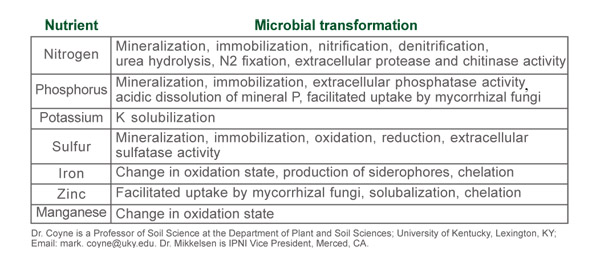
Role of Microbes
Sustainable crop production is essential to a healthy and adequate food supply. At first glance, a healthy crop reveals only the above ground plant; the roots that support the invisible plant are seldom seen. But these plant roots grow in an incredibly complex environment, teeming with billions of soil organisms, particularly bacteria and fungi, which play a crucial role in promoting root health and maintaining an adequate supply of plant nutrients for crop growth. There is still much to learn about the complex interaction between soil microorganisms and plant nutrition, but the importance of these relationships are now clearly recognized. Only a few of the key interactions between soil microbes and plant nutrition can be discussed in this brief summary. It has long been observed that plants conspicuously modify their soil environment by exuding large amounts of carbon from their roots. This rhizosphere zone becomes a biological hotspot in the soil. Adding carbon to the soil surrounding the roots leads to a huge increase in the number of microorganisms living within and outside the roots. These root exudates are composed of a complex mixture of low-molecular weight compounds such as amino acids, organic acids, sugars, and phenolics. Root mucilage, a carbon-rich gel layer surrounding the root tip, also provides a complex mixture of sugars, proteins, and enzymes to rhizosphere organisms. In some plants, as much as one-third to one-half of all the total carbon assimilated by photosynthesis can be transferred to the soil through the roots (Kuzyakov and Domanski, 2000). As soluble carbon is released by roots, microorganisms are stimulated and colonize the soil surrounding the roots. This can result in competition for nutrients because plants and microbes rely on the same essential nutrients for growth.
With the global Living organisms have a crucial role in controlling the transformations of plant nutrients in soil. In most soils, N, P and S are mainly present as various organic compounds that are unavailable for plant uptake.population heading towards eight billion by the year 2020, it has become essential to improve global environment and to increase our agricultural productivity without compromising on the depletion of nature. Excessive use of chemical in isolation in our routine life and at agricultural farms as inputs can provide the necessary benefits but their unscrupulous usage has had a catastrophic impact on human health and environment. The need of the hour is a non-toxic and ecologically – friendly approach to live healthier life and farm management.
Understanding the role of microorganisms in regulating the conversion of these organic pools into plant available forms has received considerable attention from soil scientists and agronomists. The microbial conversion of nutrients into a soluble form takes place through numerous mechanisms. Extracellular enzymes and organic compounds can be specifically excreted to solubilize plant-available nutrients from soil organic matter, crop residues, or manures. Organic acids released by microbes can dissolve precipitated nutrients on soil minerals and speed mineral weathering. Nutrients can be made more soluble (e.g., Fe) as microbes derive energy from oxidation and reduction reactions. Management practices, including tillage, irrigation, residue placement, manure utilization, addition of specific biological inhibitors and stimulators, and inoculation are all commonly Soil microorganisms provide an essential function in nourishing and protecting plants. They also play a crucial role in providing soil, air, and water services that are absolutely critical to human survival. Understanding this linkage allows better nutrient management decisions.

Soil microorganisms provide an essential function in nourishing and protecting plants. They also play a crucial role in providing soil, air, and water services that are absolutely critical to human survival. Understanding this linkage allows better nutrient management decisions.
Selected examples of microbially mediated soil transformations that influence plant nutrient availability.

References
- Geissler, D. and K.M. Scow. 2014. Better Crops with Plant Food 98(4):13-15. Haichar, F.Z., C. Santaella, T. Heulin, and W. Achouak. 2014. Soil Bio. Biochem. 77:69-80.
- Kuzyakov, Y. and G. Domanski. 2000. J. Plant Nutr. Soil Sci.163:421-431. Ogilvie, L.A., P.R. Hirsch, and A.W. Johnston. 2008. Microb. Ecol. 56:525-537














